Ahsan A. (ed.) Evaporation, Condensation and Heat transfer
Подождите немного. Документ загружается.

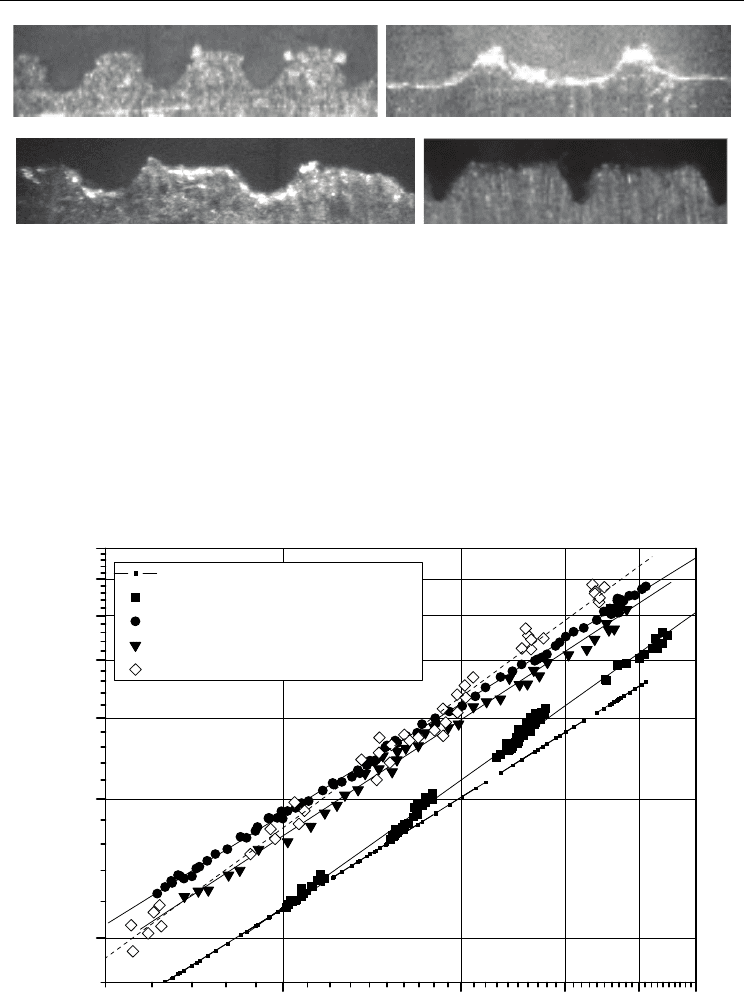
Heat Transfer and Hydraulic Resistance in Rough Tubes Including with Twisted Tape Inserts
489
a b
c d
Fig. 2. Photos of the profiles of thread roughness: a) Δ=0,11 mm, t=0,3 mm; b) Δ=0,12 mm,
t=0,5 mm; c) Δ=0,09 mm, t=0,5 mm; d) Δ=0,17 mm, t=0,6 mm
On entry and exit of channel the rectilinear sections for flow stabilization have been installed
with inner diameter equal d and with relative length L/d=100.
Dependence of a dimensionless heat transfer of tubes with a various continuous roughness
on Reynolds number Re is presented on fig. 3 (Nu – Nusselt number, Pr
f
and Pr
w
- Prandtl
numbers at average temperature of flow and wall accordingly). Diameter of an equal
volume smooth tube was used as equivalent diameter d
e
in similarity numbers.
Experimental data have satisfactory qualitative conformity with experimental data of a
tubes with the full triangular profile thread roughness in observed range Re (Isachenko,
1965).
20000 40000 60000 80000 100000
50
100
150
200
250
300
350
Smooth tube (by calculation)
Δ=0.11 mm, t=0.3 mm (fig. 2, a)
Δ=0.12 mm, t=0.5 mm (fig. 2, b)
Δ=0.09 mm, t=0.5 mm (fig. 2, c)
Δ=0.17 mm, t=0.6 mm (fig. 2, d)
Nu/(Pr
f
0,43
(Pr
f
/Pr
w
)
0,25
Re
Fig. 3. Dependence of dimensionless heat transfer of rough tubes on Re
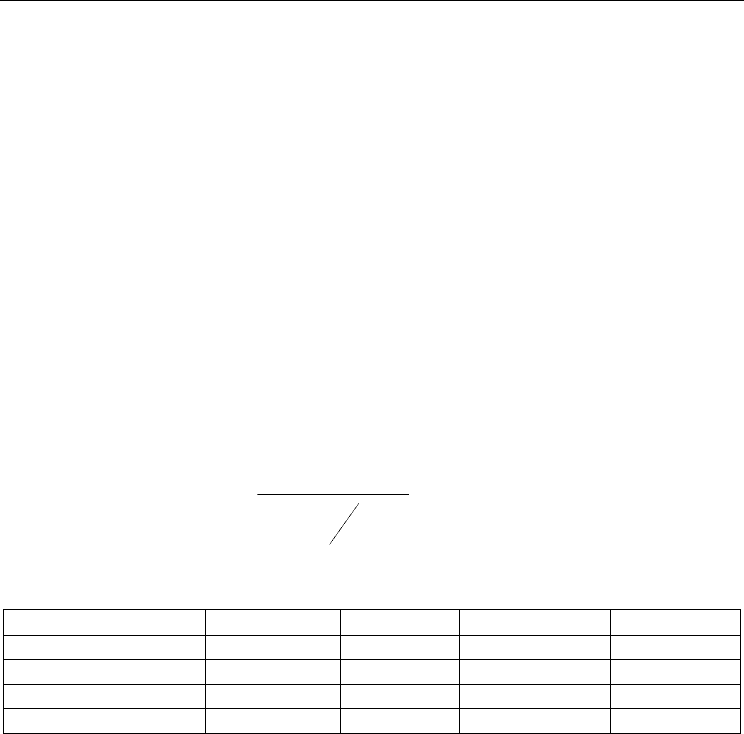
Evaporation, Condensation and Heat Transfer
490
As it has been noted the intensity of heat transfer and hydraulic resistance in tubes with
various aspects of roughness is rather individual and is defined not only a relative height
of roughness elements but their shape and disposing density on a surface. Therefore the
tube with rather smaller height of a roughness (with a profile shown in fig. 2, c) has a
higher heat transfer rate than a tube with higher roughness height (with the profile shown
in fig. 2, a). In a tube with relatively narrow dints between ledges (a profile photo in fig. 2,
a) the heat transfer growth in comparison with a smooth tube is manifested only at high
Reynolds numbers (at Re=80000 an increase in the heat transfer rate as compared to
smooth tube is 14 %). With increase of space between ledges the generation of vortexes is
augmented in each element, the penetration of a main stream into the gap between ledges
gain in strength as well as the interchanging of energy between vortexes and a main
stream (Ibragimov et al., 1978). Stability of vortexes in a gap is also downgraded, the
probability of their penetration into a flow kernel is augmented. At rather narrower and
deep dint between the ledges the vortex is inside the dint, while in another case the votex
structures leave a dint in a flow kernel, and the heat transfer is augmented. The heat
transfer rate in rough tube with the almost same ledge height but with a larger gap
between ledges (the profile photo in fig.2, b) is 1.7 times higher in comparison with a
smooth tube in all observed range of Re.
The experimental data presented in fig.3 can be described by the next relationship:
⎛⎞
⎜⎟
⎝⎠
n
0.25
f
0.43
f
w
Nu
= С ×Re
Pr
Pr
Pr
. (1)
The gained factors C and n are presented in table 1.
Roughness
Δ
, mm
t, mm n С
Fig.2, a 0.11 0.3 0.91 0.0067
Fig.2, b 0.12 0.5 0.8 0.035
Fig.2, c 0.09 0.5 0.84 0.021
Fig.2, d 0.17 0.6 0.94 0.0077
Table 1. Generalizing factors
Generalizing dependence has not been gained since the shapes of a roughness profile
essentially differ.
In tubes with the relatively narrow dints (with a profile in fig. 2, a and in fig.2, d) the extent
of agency of a Reynolds number (factor n) is more that is linked with various developing
process of a roughness with increase in number Re: the agency of roughness ledges with
narrow dints is poorly expressed at relatively small Reynolds number and augmented with
growth of Re.
In a tube with the large pitch between ledges the factor of hydraulic resistance ξ
(ξ=2ΔP/(ρV
2
)⋅d
e
/L, where ΔP - pressure drop, ρ - mass flow density, V - average flow
velocity, L/d
e
- relative length of the channel) is also appreciable higher (fig.4).
In this case, a comparable increase in the heat transfer rate and hydraulic resistance as
against a smooth tube (Nu
0
and ξ
0
) is observed at Re=10000…20000. With the further
increase of Re the hydraulic resistance grows livelier (fig. 5).
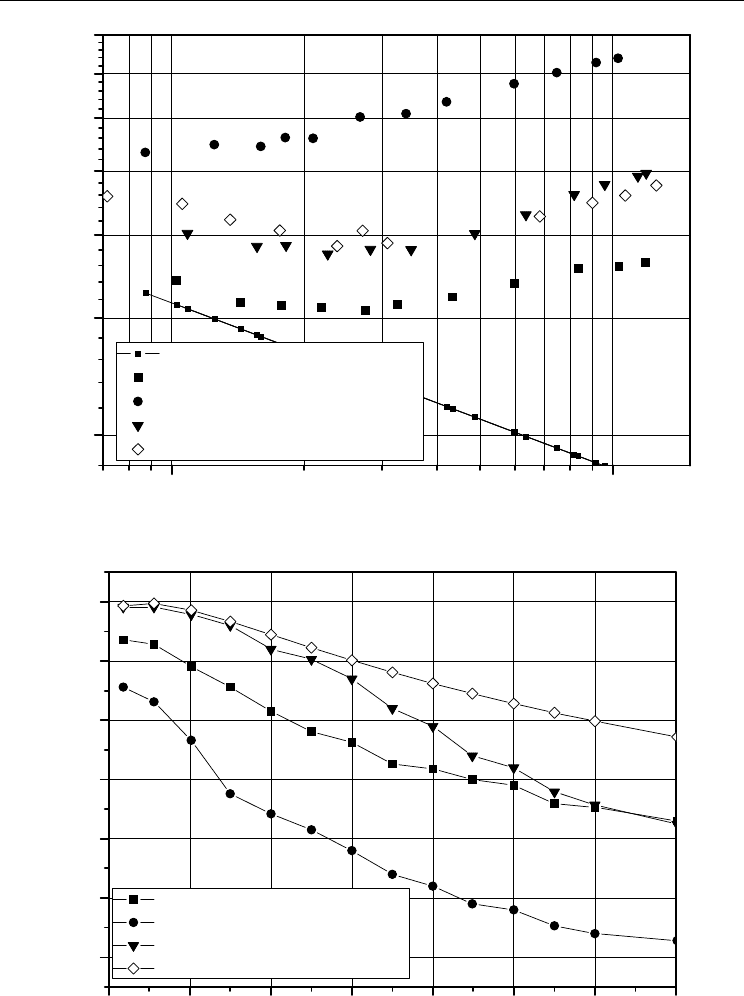
Heat Transfer and Hydraulic Resistance in Rough Tubes Including with Twisted Tape Inserts
491
10000 100000
0.02
0.03
0.04
0.05
0.06
0.07
0.08
Smooth tube (by calculation)
Δ=0.11 mm, t=0.3 mm (fig. 2, a)
Δ=0.12 mm, t=0.5 mm (fig. 2, b)
Δ=0.09 mm, t=0.5 mm (fig. 2, c)
Δ=0.17 mm, t=0.6 mm (fig. 2, d)
ξ
Re
Fig. 4. Dependence of hydraulic resistance factor of rough tubes on Re
10000 20000 30000 40000 50000 60000 70000 80000
0,4
0,5
0,6
0,7
0,8
0,9
1,0
Δ=0.11 mm, t=0.3 mm (fig. 2, a)
Δ=0.12 mm, t=0.5 mm (fig. 2, b)
Δ=0.09 mm, t=0.5 mm (fig. 2, c)
Δ=0.17 mm, t=0.6 mm (fig. 2, d)
(Nu/Nu
0
)/(ξ/ξ
0
)
Re
Fig. 5. Thermohydraulic efficiency of rough tubes
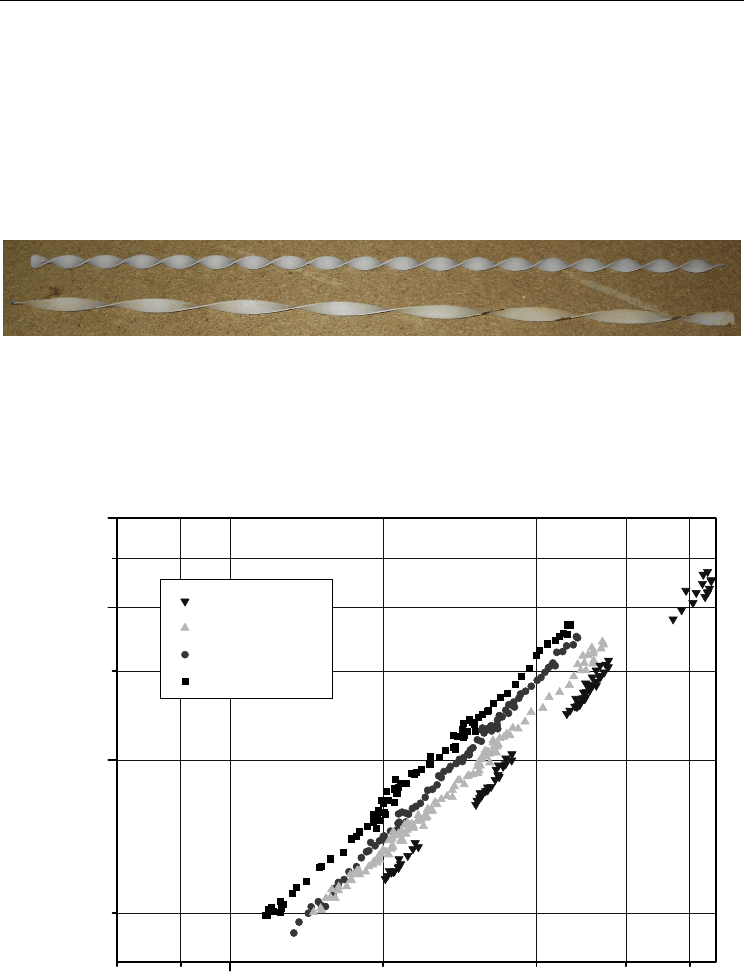
Evaporation, Condensation and Heat Transfer
492
2.1.2 Heat transfer and hydraulic resistance in different rough tubes with twisted tape
inserts at water flow
For a flow twisting in rough tubes with roughness profiles shown in fig. 2 the twisted tape
(width is 0.7 mm) was inserted into tube. The tapes have been covered by a high-
temperature varnish for creation of electric isolation with a channel wall. Relative pitches
of a tape twisting at turn on 180
0
was S/d=2.5 … 6 (a photo shown in fig. 6). Hereinafter
at machining of experimental data the similarity numbers paid off using equivalent
diameter of the equal volume smooth tube taking into account a tape insert (in a tube
cross-section).
Fig. 6. Tapes with a minimum (S/d = 2.5) and maximum (S/d = 6) relative pitches of twisting
Presence of the twisted tape insert in a tube with a uniform continuous roughness leads to
a heat transfer intensification (fig. 7, 8). In a tube with relatively large pitch between
ledges the twisting effect decreases with growth of Reynolds number Re (fig. 8), i.e. the
twisting a little suppresses the turbulent perturbations which oscillate by roughness
ledges.
6000 8000 20000 40000 60000 80000
50
100
150
200
250
300
Re
Nu/(Pr
0.43
(Pr
f
/Pr
w
)
0.25
)
without tape
S/d=6
S/d=3.5
S/d=2.5
Fig. 7. Heat transfer in a tube with uniform continuous roughness (Δ=0.11 mm, t=0.3 mm,
shown in fig. 2,а) and twisted tape inserts

Heat Transfer and Hydraulic Resistance in Rough Tubes Including with Twisted Tape Inserts
493
6000 8000 20000 40000 60000 80000
50
100
150
200
250
300
Re
Nu/(Pr
0.43
(Pr
f
/Pr
w
)
0.25
)
without tape
S/d=2.5
S/d=3.5
S/d=6
Fig. 8. Heat transfer in a tube with uniform continuous roughness (Δ=0.12 mm, t=0.5 mm,
shown in fig. 2, b) and twisted tape inserts
This is also confirmed by investigations of heat transfer in a tube with a discrete (by
knurling) roughness (the photo shown in Fig. 9) and with an inserted twisted tape (Fig. 10).
A negative effect of flow twisting on heat transfer in a discretely rough tube is noted. The
macro vortexes appearing in the channel with twistig suppress the mechanism of flow
turbulization in a discretely rough channel. It leads to a decrease in the heat-transfer rate.
Thus, the use of twisting to intensify heat transfer can be inadvisable at relatively high
ledges of roughness which considerably turbulize the flow area near the wall.
a) b)
Fig. 9. Photos of a discretely rough tube: a) outside view; b) sectional view
From the results of comparing the rate of heat transfer from rough and smooth tubes with
an identical twisted tape insert (fig. 11) the same specific features were noted as in tubes
without a tape (fig. 3): in a tube with a relatively large pitch between the ledges a
considerable increase in the heat transfer rate is observed in the entire range of Re; in a tube
with a small pitch an increase in the heat transfer rate is insignificant and manifests itself
only at high Re.
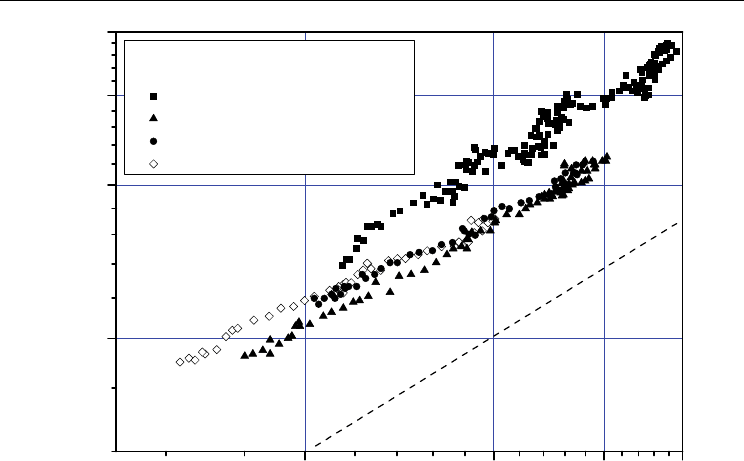
Evaporation, Condensation and Heat Transfer
494
20000 40000 60000 80000
100
200
300
400
Re
Nu/(Pr
0,43
(Pr
f
/Pr
w
)
0,25
)
------- Smooth tube (by calculation)
Disctetly rough tube:
without tape
S/d=6
S/d=4
S/d=2.5
Fig. 10. Heat transfer in discretely rough tube with twisted tape insert
Moreover, a rough tube with the profile shown in Fig. 2, c which without a tape has a
smaller heat transfer rate (fig. 3) than the tube with a profile form fig. 2, b in the presence of
a tape (especially at high Re and tight twisting S/d = 2.5) has a noticeably higher heat
transfer rate. This is due to the reasons indicated above: the twisting suppresses vortex
formation between the ledges with a large pitch between them. Thus it’s possible to obtain
an optimum combination of the parameters of twisting and surface roughness.
In rough tubes with twisted tape insert the increase in the hydraulic resistance (Fig, 12), as
against the increase in the heat-transfer rate, is commensurable with an analogous relation
for rough tubes without a tape.
2.1.3 Features of water boiling in rough tubes
The results of heat transfer in developed bubble boiling in rough tubes with a twisted tape
insert are presented in Figs. 13 and 14. They allow one to draw the conclusions analogous to
those made for heat transfer in convection. It is seen that with a decrease in the flow velocity
V and an increase in the heat flux q the heat transfer data approach the heat transfer lines for
pool boiling. The lines of pool boiling on rough surfaces are much higher than the lines of
pool boiling on a smooth surface. The heat transfer rate in boiling in a rough tube with
roughness profile shown in fig.2, a is higher by 15-20% than in boiling on a smooth surface
(fig. 13), and with roughness profile shown in fig.2, b is higher already by 70% (fig. 14). This
is attributable to different specific areas of heat-transfer surfaces and to the conditions of the
heat flux distribution on the surface of boiling caused by the geometry of the tube wall.
Moreover, the boiling heat transfer rate in a rough channel with a relatively large pitch is
notably higher due to the higher convective component of heat transfer.
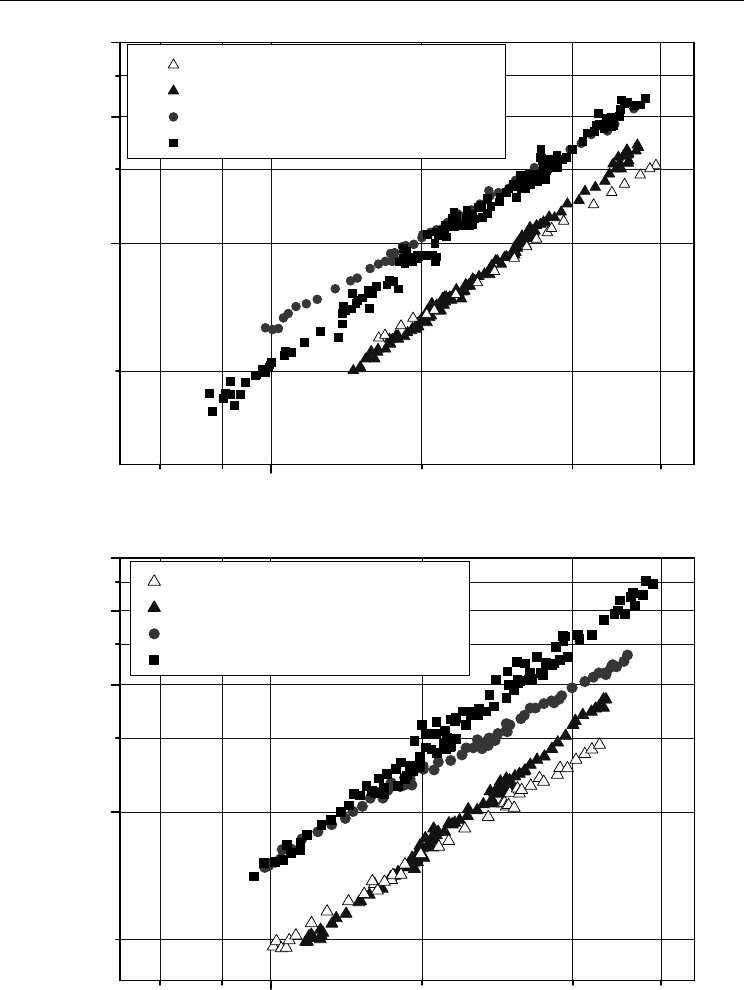
Heat Transfer and Hydraulic Resistance in Rough Tubes Including with Twisted Tape Inserts
495
6000 8000 20000 40000 60000
100
200
300
Nu/(Pr
0.43
(Pr
f
/Pr
w
)
0.25
)
Re
Smooth tube
Δ=0.11 mm t=0.3 mm (fig. 2, a)
Δ=0.12 mm t=0.5 mm (fig. 2, b)
Δ=0.09 mm t=0.5 mm (fig. 2, c)
a)
6000 8000 20000 40000 60000
100
200
300
400
Smooth tube
Δ=0.11 mm t=0.3 mm (fig. 2, a)
Δ=0.12 mm t=0.5 mm (fig. 2, b)
Δ=0.09 mm t=0.5 mm (fig. 2, c)
Nu/(Pr
0,43
(Pr
f
/Pr
w
)
0,25
)
Re
b)
Fig. 11. Heat transfer of rough tubes with twisted tape insert: а) S/d=6, б) S/d=2.5
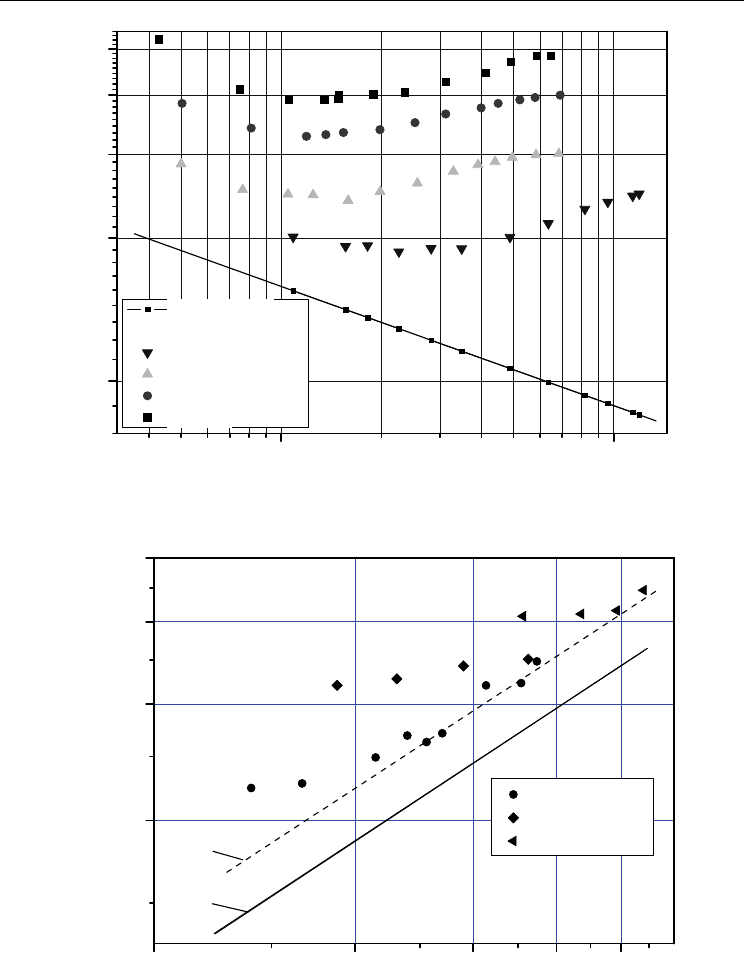
Evaporation, Condensation and Heat Transfer
496
10000 100000
0,02
0,04
0,06
0,08
0,1
Smooth tube
Rough tube:
without tape
s/d=6
s/d=3.5
s/d=2.5
ξ
Re
Fig. 12. Hydraulic resistance of tubes with a uniform continuous roughness (with profile
shown in fig.2, c) and with an inserted twisted tape
200000 400000 600000 800000 1000000
20000
30000
40000
50000
q
,W/m
2
α,
W/(m
2
K)
V=1.3 m/sec
V=1.9 m/sec
V=2.5 m/sec
2
1
Fig. 13. Dependence of the heat transfer factor α on the heat flux q at water boiling
(pressure p=0.14 MPa) in a tube with roughness shown in fig. 2, a: 1 – heat transfer at pool
boiling on smooth wall (by calculation); 2 - heat transfer at pool boiling on rough wall
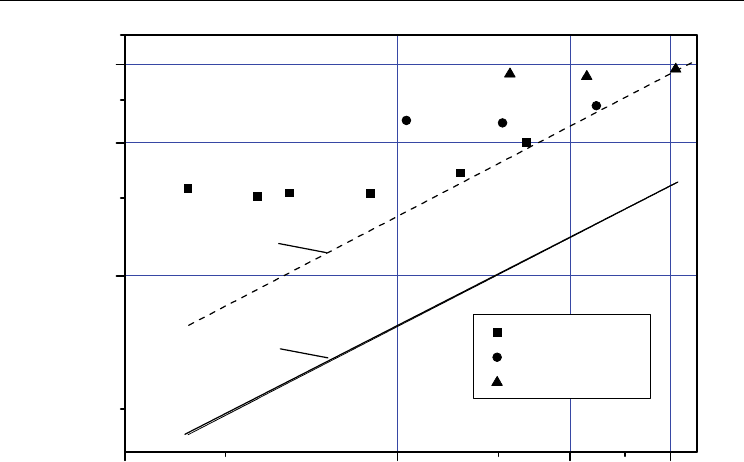
Heat Transfer and Hydraulic Resistance in Rough Tubes Including with Twisted Tape Inserts
497
100000 300000 600000 900000
20000
40000
60000
2
1
α,
W
/(m
2
K)
V=1.3 m/sec
V=1.8 m/sec
V=2.5 m/sec
q
,W/m
2
Fig. 14. Dependence of the heat transfer factor α on the heat flux q at water boiling
(pressure p=0.155 MPa) in a tube with roughness shown in fig. 2, b: 1 – heat transfer at pool
boiling on smooth wall (by calculation); 2 - heat transfer at pool boiling on rough wall
2.2 Hydraulic resistance of tubes with the twisted tape inserts and with the full thread
roughness with the various shape of ledges at air flow
2.2.1 Hydraulic resistance of tubes with the full thread roughness with the various
shape of ledges at air flow
Also experiments have been executed by definition a hydraulic resistance of rough tubes at
an adiabatic air flow at the Mach number M<0.3. The tube roughness was attained by
cutting of a thread various a profile in a plastic tube with inner diameter d=12.6 mm with
pitchs t=0.25…1.25 mm and average height of a ledges Δ =0.1…0.71 mm (table 2). Three
basic profiles of ledges were examined: triangular, rectangular and rounded.
In fig. 15-17 experimental data on hydraulic resistance of tubes with the thread roughness
various a profile are displayed. It is obvious that with increase in a pitch of a thread t and
accordingly increase in a height of roughness ledges Δ the hydraulic resistance is
augmented. As well as by results of other researches (Ibragimov et al., 1978; Isachenko et al.,
1965; et al.) the curves of hydroresistance are not the monotonic, the sites with extremes are
observed.
In fig. 18 the comparison of a hydraulic resistance of rough tubes with various roughness
profiles but with similar height of the ledges is presented. Apparently, the tube with the
rectangular profile has the greatest resistance, the least - with triangular. It can be linked
with presence of acute microcrimps on crossetes. Some excess of resistance of tubes with the
rounded ledges over resistance of tubes with triangular roughness ledges is linked with
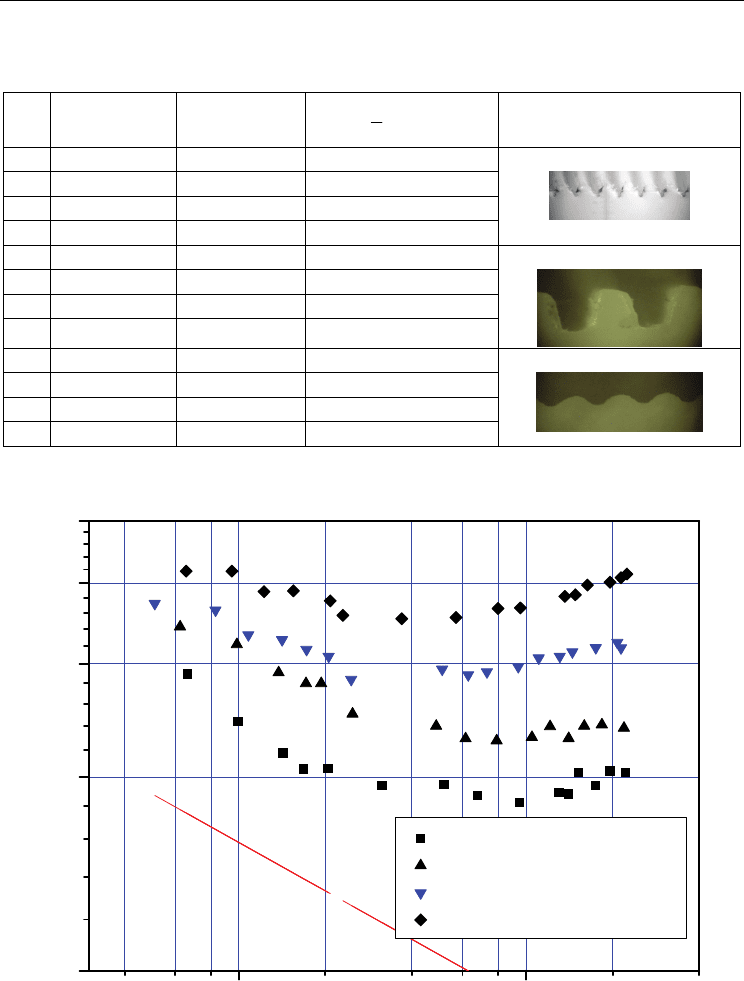
Evaporation, Condensation and Heat Transfer
498
higher pitches between the rounded ledges that promotes development of vortex
perturbations as already was noted above.
№ Pitch t, mm Height Δ, mm Relative height
Δ = Δ/d
Profile
1 0.25 0.177 0.012
2 0.5 0.34 0.023
3 0.75 0.46 0.034
4 1 0.71 0.055
triangular
5 0.5 0.175 0.013
6 0.75 0.33 0.025
7 1 0.4 0.03
8 1.25 0.6 0.046
rectangular
9 0.5 0.1 0.008
10 0.75 0.175 0.013
11 1 0.3 0.023
12 1.25 0.4 0.03
rounded
Table 2. Profiles of the thread roughness of plastic tubes
10000 100000
0,02
0,04
0,06
0,08
0,1
t=0.25 mm (¹ 1, table 2)
t=0.5 mm (¹ 2, table 2)
t=0,75 mm (¹ 3, table 2)
t=1 mm (¹ 4, table 2)
Re
ξ
Fig. 15. Dependence of hydraulic resistance factor of rough tubes with triangular thread
roughness profile on Re: line – for smooth tube (by calculation)
